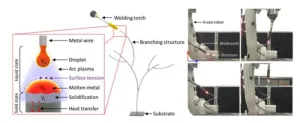(Press-News.org) A team of botanists from Ecuador, Germany, and the United States has described two new species of carnivorous plants with striking appearance. They are part of the butterworts (genus Pinguicula), a group of flowering plants with about 115 species that can catch and digest small insects with their sticky leaves. Whereas the majority of butterwort species is distributed in the northern hemisphere, these new species were discovered in the high Andes of southern Ecuador, close to the border with Peru.
Carnivorous plants use animals (usually small insects) as an additional source of nutrients to compensate the nutrient deficiency of the substrate they’re growing in. This gives them a competitive advantage over other plants and enables them to thrive in challenging habitats. The tropical high Andes have a variety of such habitats, for example marshland and rocky slopes covered in constant rain and clouds.
The two new species described in the study, Pinguicula jimburensis and Pinguicula ombrophila, were found on the shore of a highland lagoon at 3400 m and on a nearly vertical rock face at 2900 m, respectively. Their small-scale habitats lie within the so-called Amotape-Huancabamba zone, which encompasses large portions of southern Ecuador and northern Peru. This area is characterized by exceptional biodiversity, due in part to the fact that the rugged terrain and varied climate of the Andes provide so many microhabitats.
"And as small and scattered as the species' suitable habitats are, so is the species composition," says senior author Tilo Henning of Leibniz Center for Agricultural Landscape Research (ZALF), who is a specialist in this plant family in this region. His colleague Álvaro Pérez of the Pontifica Universidad Catolica del Ecuador and his team were the first to discover the plants. They then got in touch with Henning.
"Both of these new species are only known from a single location, where only a few dozens of plant individuals occur in each case." For one of them, only one population with about 15 mature individuals was discovered, making it vulnerable even if it is hidden in an isolated, difficult-to-access area. This narrow endemism (limited distribution in a particular area) is typical of the Amotape-Huancabamba zone, and there are many more new plant and animal species awaiting discovery, Henning says.
With the description of these two new species, the number of Pinguicula species recorded in Ecuador has tripled, as previously only P. calyptrata was known, discovered by none other than Alexander von Humboldt. The authors are convinced that there are many more new species awaiting formal scientific recognition, but admit that lately it has been a race against time.
“The results presented in this study show that the assessment of the Neotropical biodiversity is far from complete. Even in well-known groups such as the carnivorous plants, new taxa are continuously discovered and described, in particular from remote areas that become accessible in the course of the unlimited urban sprawl,” Henning, Pérez, and their colleagues write in a scientific article dedicated to the new plants that was published in the peer-reviewed journal PhytoKeys. “This is both encouraging and worrying at the same time“.
“Relentless urban sprawl and the accompanying destruction of habitats pose a massive threat to biodiversity in general, and to the tightly-knit and specialized organisms that depend on their fragile microhabitats in particular,” Henning points out. Although the two new species are relatively safe from direct human interference - as they both occur within protected areas - human-induced climate change is increasingly affecting ecosystems regardless of location, especially those that rely on regular precipitation, such as mountain wetlands.
The dependence on a constant climate is even reflected in the name of one of the two new species: Pinguicula ombrophila means “rain-loving butterwort”, as the plant prefers very wet conditions, receiving moisture from the waterlogged paramo-soil and enjoying the frequent rain and fog typical for this area.
Research article: Pérez ÁJ, Tobar F, Burgess KS, Henning T (2023) Contributions to Ecuadorian butterworts (Lentibulariaceae, Pinguicula): two new species and a re-evaluation of Pinguicula calyptrata. PhytoKeys 222: 153-171. https://doi.org/10.3897/phytokeys.222.98139
END
Two striking new species of carnivorous plants discovered in the Andes of Ecuador
2023-03-27
ELSE PRESS RELEASES FROM THIS DATE:
Global population could peak below 9 billion in 2050s
2023-03-27
The new projection is significantly lower than several prominent population estimates, including those of the United Nations. The researchers go further to say that if the world takes a “Giant Leap” in investment in economic development, education and health then global population could peak at 8.5 billion people by the middle of the century.
The new projections by researchers from the Earth4All initiative for the Global Challenges Foundation is published as a working paper People and Planet, 21st Century Sustainable Population Scenarios and Possible Living Standards Within Planetary Boundaries.
The team used a new system ...
Looking from different perspectives! Proper electronic structure of near-infrared absorbing functional dyes discovered
2023-03-27
Near-infrared light, whose wavelength is longer than visible light, is invisible and can pass through many substances. Organic materials that efficiently absorb near-infrared light are essential for technological innovations that utilize near-infrared light, such as the dyes in the infrared blocking filters of smartphone cameras and security inks. These and many more technical applications make developing new dyes that can absorb longer wavelengths of near-infrared light desirable.
Previously, near-infrared absorbing organic materials were treated as closed-shell molecules without unpaired electrons. However, a joint research group led by Associate Professor Takeshi Maeda, Assistant Professor ...
Bodies of people with mental illness are biologically older than their actual age
2023-03-27
New research shows that people with a lifetime history of mental disorders such as depression, bipolar disorder, or anxiety disorders have blood markers suggesting that they are older than their actual age. This may go some way to explaining why people with mental health problems tend to have shorter lifespans and more age-related diseases than the general population.
Dr Julian Mutz and Prof Cathryn Lewis, from King’s College London, looked at data on 168 different blood metabolites from 110,780 participants in the UK Biobank2. They linked these data to information on whether individuals had a history of mental illness and found that those with a mental illness ...
Study identifies two promising molecular targets for drug development in recurrent and metastatic cervical cancer
2023-03-27
NRG Oncology GOG-0240 is the phase 3 randomized trial which demonstrated that the incorporation of bevacizumab with chemotherapy resulted in a statistically significant and clinically meaningful survival benefit for women with recurrent and metastatic cervical carcinoma (NCT00803062). GOG-0240 was a proof of concept in anti-angiogenesis therapy and a proof of principle in supportive care and led directly to an indication for bevacizumab in this disease in over 60 countries. Whole genome sequencing and whole exome sequencing of tumor samples obtained in GOG-0240 suggest that ARID1A and PIK3CA could represent potential targets ...
'Nano inks' could passively control temperature in buildings, cars
2023-03-27
World-first ‘phase change inks’ that could transform how we heat and cool buildings, homes and cars – to achieve sophisticated ‘passive climate’ control – have been developed, with enormous potential to help reduce energy use and global greenhouse gas emissions.
New research published in The Royal Society of Chemistry’s Journal of Materials Chemistry A led by Dr Mohammad Taha, documents proof-of-concept ‘phase change inks’ that use nanotechnology to control temperature in everyday environments. They achieve this by adjusting the amount of radiation that can pass through ...
Project helps thousands of people in England and France into employment and entrepreneurship
2023-03-27
New research led by the University of East Anglia (UEA) shows that large infrastructure projects which are the focus of the UK government’s levelling up agenda and include support for business start-ups, must also offer sustainable, local investment in deprived communities.
Through place-based micro-enterprise training and employment support over a longer time frame, lasting local impact can be demonstrated, according to the study’s policy recommendations.
Supporting people to return to their communities, increasing social cohesion within them, boosting digital literacy and enabling net zero jobs are also likely to play a role.
These goals can be easily ...
Embryos’ development is delayed in pregnancies that end in miscarriage
2023-03-27
Embryos in pregnancies that end in miscarriage take longer to develop in the womb than those in pregnancies that result in live births, according to new research published today (Monday) in Human Reproduction [1], one of the world’s leading reproductive medicine journals.
For the first time, researchers in The Netherlands have been able to look at the way embryos develop while pregnancies are ongoing. They used state-of-the-art imaging technology, including 3D ultrasound with high resolution transvaginal probes and ...
Global analysis of coronavirus protein research reveals how countries respond to disease
2023-03-27
In a new study, researchers examined how a country’s number of published 3D protein structures for coronaviruses, including the one responsible for COVID-19, correlated with its economic output and population. The findings reveal important insights into how different countries' research establishments respond to disease outbreaks and could be useful for planning responses to future pandemics.
The study showed that countries with larger economies generated more 3D structure determinations for the protein components ...
Shh! Intensive care incubators resonate sounds and risk damage to premature babies’ hearing, scientists say
2023-03-27
For vulnerable premature babies, an incubator in the neonatal intensive care unit (NICU) is a lifesaver, but the consequences can last a lifetime. Many studies have shown that the NICU is a noisy environment and that babies who spend time there have higher rates of hearing impairment, which can lead to delays in language acquisition. Scientists from Vienna, Hamburg, Munich, and Osnabruck set out to investigate the role of the incubator, an underestimated element in the soundscape that surrounds babies during their time in the NICU.
“The ...
Securing new metal 3D printing technology that drives the renaissance of the manufacturing industry!
2023-03-27
□ A research team led by Dr. Sang-woo Song, Dr. Chan-kyu Kim, Dr. Kang-myung Seo at the Department of Joining Technology of the Korea Institute of Materials Science(KIMS), a government-funded research institute under the Ministry of Science and ICT, has developed a foundational technology for controlling the volume of molten metal in the process of 3D printing metal using welding techniques. They achieved this through collaborative research with a research team led by Professor Young-tae Cho and Professor ...







